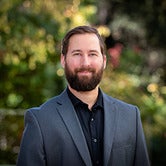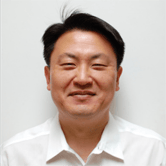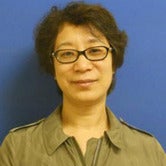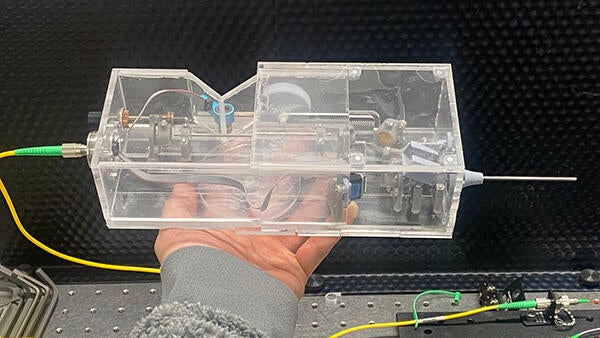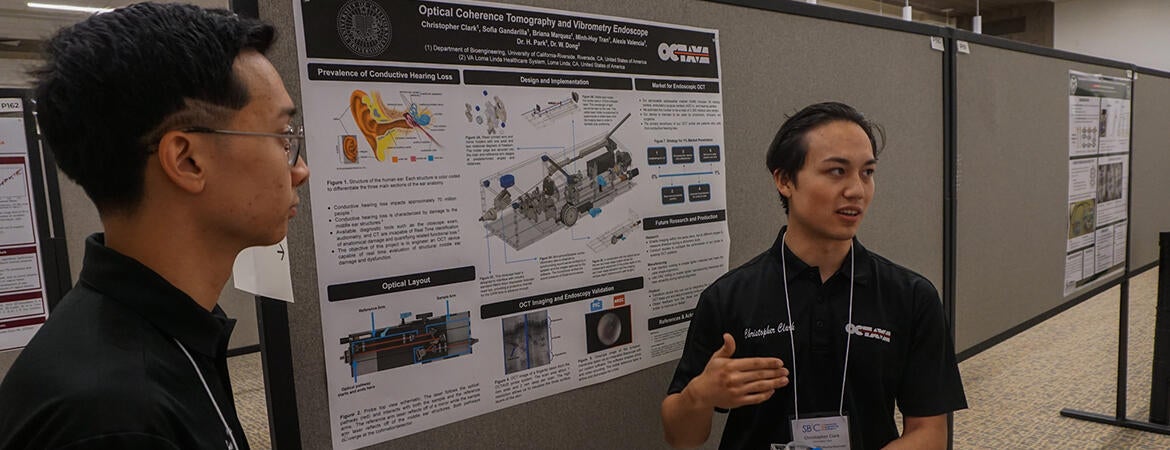
In this fourth part of a five-part series, the five undergraduate members of the Optical Coherence Tomography and Vibrometry Endoscope (OCTAVE) team share how the progress they made and design successes they achieved were only made possible through the guidance and mentorship they received from faculty members and real-world feedback and resources from industry advisors.
“I knew absolutely nothing about this project when I started it. However, because of faculty mentors and our sponsor I was able to scratch the surface of human knowledge and develop the beginnings of cutting-edge technology.”
That’s what Alexis Valencia thought as he reflected on the help he and his fellow Department of Bioengineering undergraduate students received that enabled them to successfully develop a redesigned medical device.
Valencia and teammates innovated. Faculty furnished foundational research and direction. And a sponsor at the Veterans Administration Loma Linda Healthcare System delivered funding, guidance, and feedback on market needs.
Those are the contours of a project that saw five Marlan and Rosemary Bourns College of Engineering (BCOE) undergraduates redesign a complex prototype that could transform the way clinicians measure middle-ear hearing loss.
The students — Chris Clark, Sofia Gandarilla, Briana Marquez, Minh-Huy (Huy) Tran and Valencia — took a bulky, 20-pound prototype from the lab of Hyle Park, associate professor of bioengineering, and delivered a sleek, 1.32-pound probe fit for physicians.
The result: an updated Optical Coherence Tomography and Vibrometry Endoscope (OCTAVE) that could, via precise diagnoses, help millions of people with impaired hearing.
“The consistent support from our mentors really gave us the confidence to keep pushing forward through late nights” and dozens of design iterations, Marquez said.
The team described that support as exceptional:
• It was Rob McKee, a bioengineering assistant professor of teaching and the Senior Design course instructor, who assembled what became a dream team of student engineers. He steered them toward national honors and presentation opportunities, and assisted with documents, applications, proofreading, and funding to attend conferences.
• It was Park who supplied the lab and equipment, the initial prototype, foundational research, graduate student legwork, support for proposals, expertise in optical coherence tomography (OCT), and scientific mentorship that helped the students shine.
• And it was Wei Dong, research scientist at the Veterans Administration (VA) Loma Linda Healthcare System and professor of Otolaryngology-Head and Neck Surgery at Loma Linda University, who offered the team funding, spare parts, another expert’s view, and real-world feedback from industry.
Early support from all three “kick-started a sequence of successes that led to” a National Institute of Health (NIH) Design by Biomedical Undergraduate Teams (DEBUT) award for innovation in student engineering design, Clark said.
Park’s initial guidance inspired a core design idea that shaped the students’ vision, while McKee helped the team submit an application to present their project at the international Summer Biomechanics, Bioengineering, and Biotransport Conference (SB3C) summit. Meanwhile, VA Loma Linda funded much of the project, including costly device components such as beam scanners and gradient index (GRIN) lenses for imaging, Park said.
Dong offered practical suggestions, too. Because the professor sought to use OCTAVE in her lab, “she would get her hands on the mock model and see how realistic it was for a physician to use,” Marquez said. “She would ask, ‘Is it easy? Is it intuitive?’ She’d say, for instance, that maybe we should shift the knob to another part of the case to be more intuitive for physicians.”
Valencia also praised BCOE equipment, including a laser cutter and 3D printer.
“I believe this was another huge factor that allowed us to be successful in our project,” he said. “I felt like a kid with many expensive toys at my disposal.”
Asked about how they help students succeed, the mentors shared their perspective.
“A lot of the research in my lab reflects my tendency to think and work hard about the best way to make things easier later on (i.e., we work through math and physics on paper and on the computer, and iterate on different imaging systems and methods), and to be open to wildly different areas, like design thinking, that might not at first seem to relate but that can be incredibly useful,” said Park, a BCOE professor for 15 years. “I think that general philosophy lends itself well to projects like this.”
McKee, in his sixth iteration teaching the Senior Design course, said his passion for the outdoors has made him a better role model for students.
“From running and hiking, you learn how to push through and persevere,” he said. “There are times when you’re on a 10-mile run or hike and just want to be done, or the flies are biting, or you twisted your ankle, but the car is several miles away so you mentally have to keep pushing. From gardening I’ve learned that the best laid plans can go sideways overnight, especially if a pest gets to the crop, as well as that it takes time. What you do at the beginning is important, but it takes time to reap the harvest.”
The instructors’ patience “emphasized progress over immediate results,” Gandarilla said, “which encouraged us to explore creative solutions without the fear of failure.”
The students definitely reaped the harvest of their diligent efforts.
Valencia — who is now enrolled in a master’s program in computational biomedical engineering at Carnegie Mellon University — credited the team’s mentors for helping him transition from having zero familiarity with a complex engineering field to becoming fluent in it. He and his teammates succeeded in putting a powerful prototype in the pipeline to market.
The mentors also helped to lift students such as Valencia from zero familiarity to fluent in a complex engineering field; put a powerful prototype in the pipeline to market; and prompt Clark to say: “What I hope to do is follow (these mentors’) example if I have a leadership role in the future.”
This story is the fourth part in a five-part series. You can read the other parts below:
The Sound of Success Part 1 - How a team of bioengineering students turned a Senior Design project into an innovative diagnostic tool for hearing loss
The Sound of Success Part 2 - Student engineers say friendship, adventure marked their experiences designing a hearing-loss innovation”
The Sound of Success Part 3 - Student engineers overcame multiple design, fabrication, software challenges to refine and bring their project to life
The Sound of Success Part 5 - Award-winning team of bioengineering students share the success factors that helped them achieve "nothing short of extraordinary.
Header image: OCTAVE team members (L-R) Alexis Valencia and Chris Clark presenting OCTAVE at the 2024 Summer of Biomechanics, Bioengineering, and Biotransports Conference. (All photos courtesy of the OCTAVE team)
